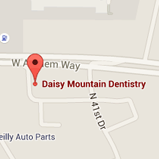Amalgam Fillings vs. White Fillings
May 11th, 2022

Many varieties of fillings are available at our Anthem office. Most people are familiar with traditional amalgam fillings: those big silver spots on top of teeth.
Made from a mixture of silver, tin, zinc, copper, and mercury, amalgam fillings have been used to fill cavities for more than 100 years. They offer several advantages, including:
- High durability for large cavities or cavities on molars
- Quick hardening time for areas that are difficult to keep dry during placement
- Reduced placement time for children and special-needs patients who may have a difficult time keeping still during treatment
Although dental amalgam is a safe and commonly used dental material, you might wonder about its mercury content. You should know that when it’s combined with the other metals, mercury forms a safe, stable material.
The American Dental Association, U.S. Centers for Disease Control and Prevention, U. S. Food and Drug Administration, and World Health Organization all agree that based on extensive scientific evidence, dental amalgam is a safe and effective cavity-filling material.
White Fillings
Newer, mercury-free, resin-based composite fillings (white fillings) are also available at our Anthem office. Composite resin fillings are made from plastic mixed with powdered glass to make them stronger.
Resin-based fillings offer several benefits for patients, including:
- They match the color of teeth
- Less tooth structure needs to be removed than with amalgam fillings
- BPA-free materials can be used
Resin-based composite fillings also have some disadvantages, including:
- Higher cost than amalgam fillings
- Inlays may take more than one visit
- Requires more time to place than amalgam fillings
There’s a lot to think about when you have to get a cavity filled. We recommend you do your homework and speak with Drs. Peter Vogel, Vijal Vadecha before deciding what’s best for you or your family.
The Root of the Matter
May 4th, 2022

A strong, healthy smile is built on a strong, healthy foundation. Let’s take a moment to explore just what creates that foundation—your roots.
The Root of the Matter
The visible part of your tooth is called the crown. And while we spent the great majority of our time thinking about what goes on above the gum line—brushing, flossing, whitening, sealing, preventing cavities—the roots, the parts of the teeth below the surface, are also essential to our dental health.
- What’s inside the root?
The inside of each tooth holds pulp, which is living tissue made of nerves, blood vessels, and connective tissue. The nerves in the pulp allow us to feel pain when a tooth is damaged, decayed, or infected. Tiny blood vessels provide oxygen and nutrients to the cells.
The inside of each root also contains pulp, located in one or more root canals. These canals are small tunnels that travel from the pulp chamber to the tip of each root. Nerves and blood vessels connect pulp tissue to the nervous and circulatory systems in the body, entering and exiting the tooth from very small openings in the root tip.
- What’s outside the root?
On the outside, while roots look like crowns, they’re covered with a different protective surface. Roots are covered by cementum rather than enamel. This is a hard tissue, but not as hard as enamel. But cementum has another advantage—it not only helps protect our teeth, it helps them stay anchored in our jaws. (More on this below.)
- How many roots are we talking about?
The number varies, not just depending on the tooth, but depending on the individual. Most adults have 32 adult teeth: eight incisors, four canines, eight premolars, eight molars, and four wisdom teeth, or third molars. Because the number of wisdom teeth can range from four to zero, though, that total can be smaller.
Rooted to the Spot
The reason that you can rely on your teeth for a lifetime of chewing, biting, and grinding food is the fact that they’re so securely anchored in the jaw.
- Alveolar bone in the jaw contains a socket for each tooth.
- A thin layer of connective tissue called the periodontal ligament lines the socket and surrounds each root. It’s filled with fibers that attach to the root’s cementum covering and to the alveolar bone, holding the tooth securely in place.
- The periodontal ligament not only anchors the tooth, it cushions it from the daily pressure of biting and chewing.
- Finally, the gums surround the teeth and bone, protecting them from bacteria and plaque.
Even though this design is very secure, there are situations where the root becomes vulnerable. In that case, you should see Drs. Peter Vogel, Vijal Vadecha at our Anthem office right away. Our goal is for you to keep your teeth healthy and strong, and for a lifetime!
Whitening Before Veneers—A Bright Idea?
April 27th, 2022

It’s time. You’ve decided. You’re going to get veneers. Whether it’s to repair a cracked or chipped tooth, to cover discoloration brought on by a root canal or medical condition, to fill in gaps between teeth, or for any other cosmetic reason, veneers can give you back your natural, confident smile.
And now you have just one more decision to make: should you whiten your teeth beforehand?
Many dental professionals find that, for most of us, the best results occur with professional whitening before veneer placement. Why?
- Your veneers will be carefully matched to the teeth surrounding them.
You don’t want your veneers to look anything but natural, and so Drs. Peter Vogel, Vijal Vadecha will make sure that their color is indistinguishable from your other teeth. But there is one important difference between tooth enamel and veneers:
- Teeth are porous.
As hard as it is, enamel is still porous. And the fact that teeth are porous means that teeth can discolor over time. Coffee, tea, red wine, sodas, darkly hued fruits, and fruit juices—teeth readily absorb pigments from foods. And smoking? Not only one of the worst habits for your health, it’s one of the major causes of tooth discoloration. This is the downside of having porous enamel.
The upside? The fact that enamel is porous also means that you can brighten your smile with a whitening procedure.
- Veneers aren’t as porous.
Veneers are generally made of porcelain or a composite resin, with some key differences between them.
Porcelain has a translucent quality that looks like natural enamel, and it is very durable. Porcelain veneers are recommended when teeth have significant chips or gaps. They are also especially stain-resistant.
Composite veneers aren’t as expensive, and usually don’t need as much tooth structure removed to bond them to the tooth. They might not last as long as porcelain, and they aren’t quite as resistant to staining.
When you visit our Anthem office, we can discuss the pros and cons to find the perfect veneers for your needs. Just remember,
- Once created, veneers can’t change color.
Veneer color should be considered permanent. If your porcelain veneers seem to have dimmed a bit, often a gentle professional polishing will bring them back to their original shine. Composite veneers, as well, can respond to polishing and cleaning. This is the upside of permanent veneer color.
The downside? Veneers can’t be whitened to match your newly whitened tooth enamel. If you decide to whiten your teeth at a later date, your veneers might appear darker than your surrounding teeth. If you want to change veneer color, you will need to replace your veneers. So . . .
Now that you’ve decided to transform your smile with veneers, take a little extra time to talk to your dentist. Find out if whitening makes sense for you for a perfect, uniform match between your other teeth and your veneers. And then be ready to enjoy your matchless smile!
My teeth don't line up any more. Why?
April 20th, 2022

If your teeth don't line up like they used to any more, you may be suffering from temporomandibular joint disorder, often called TMD. This is a term that can actually be applied to any condition that occurs because the temporomandibular joint (TMJ) is inflamed.
The temporomandibular joint is essentially the hinge that holds your lower jaw to your skull, and when it is inflamed or damaged in any way, it can be extremely painful. You have two temporomandibular joint, one on each side of your jaw, and it is typical to experience TMD in both sides at the same time.
Shifting of the Teeth
The reason that your teeth may not line up as they once did is that the ball and socket joints are often out of alignment and, as mentioned above, often very inflamed as a result. In order to correct the problem, Drs. Peter Vogel, Vijal Vadecha may prescribe dental orthotics such as a lower jaw splint.
Sometimes, the wisdom teeth can play a role in the shifting of the teeth as well. If shifting wisdom teeth is combined with TMD, it may be necessary to have your wisdom teeth removed. Dental splints may follow if your teeth don't shift back to their proper positions on their own.
TMD is certainly a difficult thing to deal with, so if you experience your teeth shifting, scheduling an appointment at our Anthem office is the smartest course. We want to help you get your smile back, so give us a call anytime.


